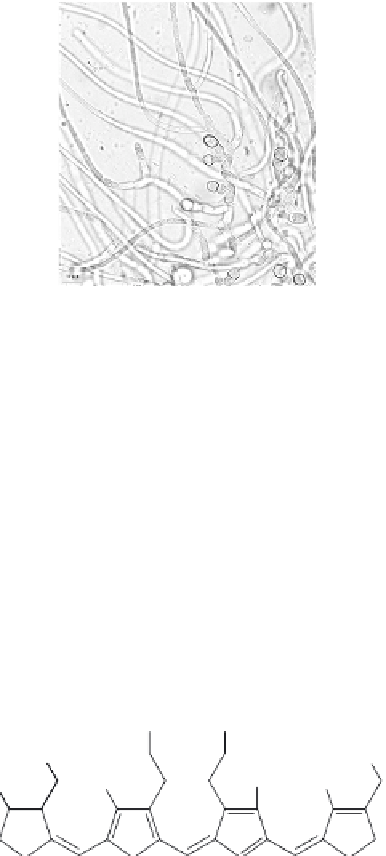Environmental Engineering Reference
In-Depth Information
Compounds and activities: The bioactive compounds isolated from this
species include phenolic acids (protocatechnic, p-hydroxybenzoic,
2,3-dihydroxybenzoic, chlorogenic, vanillic, caffeic, p-coumaric, salicylic
acid), cinnamic acid, hydroxybenzaldehydes (p-hydroxybenzaldehyde,
3,4-dehydroxybenzaldehyde) and vanillin. These compounds possess anti-
oxidative properties and have several nutritional and therapeutic applica-
tions (Onofrejova et al.,
2010).
NOSTOCHOPSIS LOBATUS
WOOD EM GEITLER
Phylum: Cyanobacteria
Class: Cyanophyceae
Order: Nostocales
Family: Nostocaceae
Distribution: Bangladesh
Habitat: Shallow rivers, streams
Description: The dark green colonies of this species, which are found attached
to rocks, possess a mucilagionous, polysaccharide sheath as an outgrowth.
Compounds and activities: The bioactive compounds isolated from this species
include δ-aminolevulinic acid, bili pigments, and antioxidants. This species
shows a high polysaccharide content of 160.02 DP on BG11 medium, and the
values of carotenoid, phycocyanin, and allophycocyanin pigments of this spe-
cies were found to be 0.339, 61.58, and 65.38 mg/g cell (dw), respectively. This
species also showed a high concentration (37 µg/100 g dw) of selenium, a
well-known oxidant (Thiamdao et al.,
2012). The polysaccharides, phycocya-
nin and allophycocyanin, of this species could therefore be a source of supple-
mental food and are used as therapeutic agents and ingredients of cosmetics.
COOH
COOH
H
3
C
H
3
C
H
3
C
CH
3
H
3
C
H
3
C
O
O
H
H
N
H
phycocyanin






